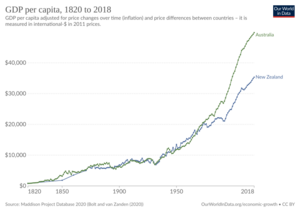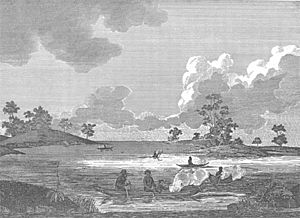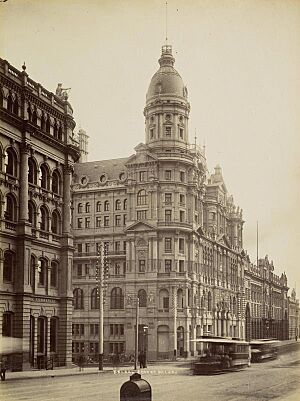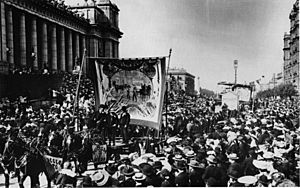Economic history of Australia facts for kids
The economic history of Australia tells the story of how Australia's economy has grown and changed since Europeans first settled there in 1788. It's a journey from a small penal colony to a modern, thriving country.
Contents
Early Days: 1788–1821
When the First Fleet arrived on January 26, 1788, at Port Jackson (now Sydney), they started a new penal colony in New South Wales. More than 1,000 convicts, marines, and sailors came, bringing supplies and animals. The British claimed this land, calling it terra nullius, which means "nobody's land," even though Indigenous people lived there.
In the beginning, the colony struggled. There wasn't much money, so rum became a common way to trade goods! Governors could give land to free settlers and former convicts. Whaling (hunting whales) started in 1791 and became one of Australia's first big export industries, bringing in more money than farming for a while.
After 1810, more convicts were sent to Australia. Many of them were skilled workers like craftsmen and clerks, which helped the new settlements grow. In 1813, settlers crossed the Blue Mountains, opening up rich farming land to the west. Australia's first inland town, Bathurst, was then established. The first bank, the Bank of New South Wales, opened in Sydney in 1817.
Growing with Wool: 1821–1850
From the 1820s, Australia's economy really started to grow thanks to fine wool production. This wool was sold to factories in Britain and Europe. To help with this trade, new banks were set up in London.
People known as 'squatters' started raising large numbers of sheep and cattle on land beyond the official settlement areas. Even though they didn't legally own the land at first, they could pay a small fee to use it from 1836.
This growth was sometimes interrupted by tough economic times, like depressions in the 1840s. However, the discovery of gold later on would change everything!
During this time, four more British colonies were started in Australia: Western Australia (1829), South Australia (1836), Victoria (1851), and Queensland (1859). Van Diemen's Land (now Tasmania) became a separate colony in 1825.
The expansion of settlements had a huge impact on the Indigenous population. Their land and resources were taken, leading to disease, violence, and forced removals.
By the 1830s, wool had become Australia's most important export, replacing whale oil. By 1850, New South Wales was the main supplier of wool to British industries.
The Gold Rush Era: 1850–1860
The discovery of gold in 1851 caused huge gold rushes across Australia! Many people left their jobs to search for gold, and a massive number of people came from overseas to join the rush.
Victoria became the center of gold mining. Its population exploded from 76,000 in 1851 to 540,000 in 1861. Australia's total population more than tripled in just 20 years!
The gold rush brought enormous wealth, especially to Melbourne. The city grew rapidly, with new suburbs appearing. This wealth also led to a boom in building schools, churches, libraries, and art galleries. Australia's first telegraph line was built in Melbourne in 1853, and the first railway in 1854. The University of Melbourne was founded in 1855.
Boom and Progress: 1860–1875
The money from gold and wool continued to fuel a strong economy through the 1860s and 1870s. Victoria faced a shortage of workers, which pushed wages up, making them some of the highest in the world. This led to Victoria being called "the working man's paradise." Workers even won the right to an eight-hour day in 1856.
Australia's first stock exchange opened in Melbourne in 1861. New laws in New South Wales also tried to make land more available for farming, breaking the control of the large squatters.
Investment and Challenges: 1875–1900
As good farming land became harder to find, wool production still grew, but profits started to slow down. However, foreign investors continued to pour money into Australia, especially for transport like railways. This meant Australians had some of the highest incomes per person in the world in the late 1800s.
But by the end of the 1880s, overseas investors became worried about their returns. A financial crisis in 1890, though focused on Argentina, made investors pull money out of Australia. This caused a banking crisis in Victoria, South Australia, and New South Wales, leading to a severe economic depression in the early 1890s.
However, Western Australia was less affected because huge gold reserves were discovered at Kalgoorlie and Coolgardie. This led to a new gold rush there, helping Western Australia's economy grow rapidly, developing its port at Fremantle and expanding its railway network.
The 1880s also saw a "Land Boom" in Melbourne, with land prices soaring due to speculation. This led to corruption and huge debts. When the boom ended, property values in central Melbourne wouldn't recover for many decades.
- 1890: The Great maritime strike occurred.
- 1891: The Australian shearers' strike took place.
- 1893: A major international depression hit, and many Australian banks and financial institutions struggled or collapsed.
A New Nation: 1900–1939
In 1901, the Australian colonies joined together to form the Commonwealth of Australia. The first federal government was formed. In 1904, the Australian Labor Party formed the federal government, a first for a labor movement anywhere in the world.
In 1910, Australia introduced its own national currency, the Australian pound. Its value was tied to the British pound sterling. This connection meant that when the British pound changed value, it affected Australia too. For example, when Britain left the gold standard in 1914 and returned in 1925, it caused big economic shifts in Australia. In 1929, during the Great Depression, Australia left the gold standard, which helped its economy.
While wool was still important, new exports like wheat, dairy, and other farm products grew. New technologies, like disease-resistant wheat and refrigerated shipping, helped these industries expand. This also brought in more foreign investment, leading to a boom in construction, especially homes.
However, by the late 1920s, farmers faced problems, and governments weren't getting the returns they expected from their investments. This led to a recession, which worsened as other countries also fell into depressions. This meant less foreign investment and lower demand for Australian exports. The biggest recession in Australia's history peaked in 1931–32.
Australia didn't suffer as badly as some other countries, partly because its manufacturing sector was growing. Governments used tariffs (taxes on imported goods) to protect local manufacturing, which helped it prosper.
World War II and After: 1939–1972
World War II had a huge impact on Australia's economy. Before 1939, the federal government had a small role in managing the economy. But during the war, the government took strong control, organizing the economy and workforce for the war effort. They introduced rationing, production controls, and conscription (forcing people to join the military or work in specific industries).
The government also took over collecting income tax from the states and funded the war largely from within Australia. This strong wartime economy set the stage for rapid growth after 1945.
After the war, the Labor government focused on "national development," meaning the government would control key parts of the economy to ensure growth and full employment. Some companies like QANTAS were nationalized (taken over by the government), and new government-run businesses were set up. The massive Snowy Mountains Scheme (a hydro-electric and irrigation project) began in 1948.
Australia also joined the Bretton Woods system in 1944, which set fixed exchange rates for major world currencies. Australia's currency remained tied to the British pound until 1967.
In 1949, when the British pound was devalued against the US dollar, Australia followed suit to keep its exports competitive. Later, in 1971, Australia stopped pegging its dollar to the US dollar and eventually let it "float" in 1983, meaning its value would be determined by market forces.
The new Liberal government under Robert Menzies (from 1949) still regulated the economy but encouraged private industry more. Australia enjoyed great prosperity with high economic growth, low unemployment, and increasing foreign investment. Rationing ended in 1950, and the introduction of television in 1956 helped create an affluent society. By 1967, Japan had replaced Britain as Australia's main trading partner. In 1966, Australia switched from the pound to the Australian dollar.
However, by the late 1960s, conditions started to change. Britain began moving towards joining the European Economic Community, meaning Australia would lose its special access to the British market. The US economy faced difficulties, and Australia started to see more economic competition.
Economic Challenges: 1972–1982
The post-war economic boom ended in the early 1970s with "stagflation" – a new problem where unemployment and inflation (rising prices) both increased at the same time. This was partly due to global events like the 1973 oil crisis and Britain joining the European Economic Community.
The Labor government led by Gough Whitlam (from 1972) expanded government-funded health and education programs. However, higher government spending and wage increases, without matching productivity, led to more inflation. By mid-1974, Australia was in a recession.
The government that followed, led by Malcolm Fraser, tried to control spending and inflation. However, they were slow to make big economic changes that many economists were suggesting.
Modern Economy: 1983–Present
Major economic changes, like making the economy more open and less regulated, began in the early 1980s under the Labor government led by Bob Hawke. They made an agreement with trade unions to keep wages steady in exchange for other benefits, which helped them introduce reforms.
These reforms included:
- Cutting tariffs (taxes on imports).
- Letting the Australian dollar "float" (its value determined by the market) in 1983.
- Deregulating the financial system.
- Selling off several large government-owned businesses, like the Commonwealth Bank, Qantas, and Telstra.
These changes led to increased productivity and less government spending compared to the country's total wealth. The Australian Securities Exchange was formed in 1987 by combining six smaller stock exchanges.
In the early 1990s, a global recession hit Australia. Paul Keating, who was Prime Minister then, famously called it "the recession that Australia had to have." During this time, Australia's total wealth (GDP) fell, and unemployment rose to 10.8%.
The process of economic reform continued under the Coalition government led by John Howard (from 1996). They introduced a Goods and Services Tax (GST) in 2000 and further deregulated labor markets.
As a result of these reforms, Australia now has one of the most open economies in the world. It has enjoyed over two decades of continuous economic growth, along with low inflation and relatively low unemployment.
Recently, growth in the mining industry has been a big factor in Australia's strong economy and high Australian dollar.
Here's a look at Australia's economic growth (Gross Domestic Product - GDP) over some years:
| Year | Total Wealth (GDP) - A$m |
US$ Exchange (US$1 = A$) |
Price Index (2000=100) |
|---|---|---|---|
| 1980 | 140,987 | A$0.87 | 36 |
| 1985 | 245,596 | A$1.42 | 54 |
| 1990 | 407,307 | A$1.27 | 80 |
| 1995 | 500,458 | A$1.34 | 90 |
| 2000 | 669,779 | A$1.71 | 100 |
| 2005 | 926,880 | A$1.30 | 116 |
| 2007 | 1,044,162 | A$1.26 | 122 |
Images for kids
-
A mine in the mining town of Broken Hill, where a miner's strike happened in 1892.
-
The Sydney CBD, Australia's financial heart.







